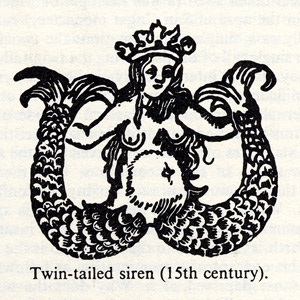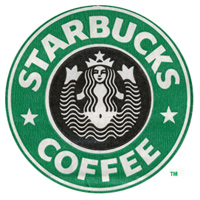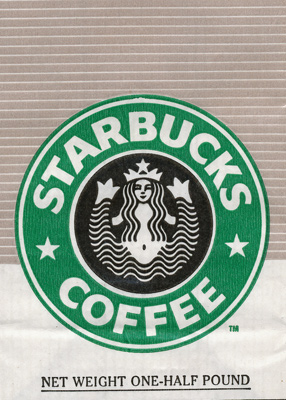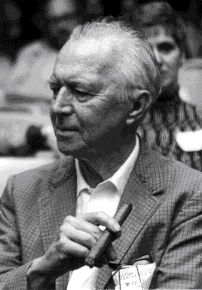[update] Starbucks logo changes again.
You are probably here because you looked closely at the Starbucks logo and were a little confused about what is depicted on it. Is it a mermaid? What are those things that she is holding up with her hands? Wasn’t the logo different before? What’s the history of it?
I asked those questions myself and did a little bit of digging. My research started with a book that I had, called A Dictionary of Symbols by J.E. Cirlot. In it there was a chapter about Sirens.
Basically, from what I gathered from different sources, including that book, there is a lot of confusion between the different mythological half-women. Typically they are called Sirens – both the half-bird/half-woman and the half-fish/half-woman varieties. The fish type are usually called Mermaids. Both types according to the ancient Greeks were in the business of seducing mariners with songs and promises of sex and then killing them, but Hans Christian Andersen and Disney mostly made everybody forget that.
The whole sex-symbol status of mermaids hinges on the question which part is “woman” – upper or lower. “The other type of mermaid” that hapless Fry was referring to would have problems attracting suitors, of course. And how do you do it with the normal type?
Wise mythologists came up with the answer, of course. And the answer is a two-tailed mermaid sometimes called a Melusine.
The book had an old engraving of a two-tailed mermaid. It reminded me of the Starbucks Siren, but back then I did not realize that the original Starbucks logo had a slightly altered version of that engraving in the original brown cigar band-shaped logo.

Notice that the graphic designer removed the belly button, the unattractive shading around the bulging tummy of the 15th century siren and merged the tail-legs to remove the suggestion of naughty bits. The logo Siren also smiles a little while its 15th century doppelganger is looking rather grim. Other than that it’s clear that this is exactly the image that he or she was using.

According to uspto.gov “[Starbucks] mark consists of the wording “Starbucks Coffee” in a circular seal with two stars, and the design of a siren (a two-tailed mermaid) wearing a crown”.
Here’s the “cigar band” logo from which I took the image above. The original hippie Starbucks owners did not sell espresso drinks, but mostly sold coffee beans, tea and spices. Today Starbucks sells liquor and ice cream, but no spices if you don’t count the cinnamon gum and the stuff on the condiment table.

The next, more familiar green iteration of the logo has a more attractive stylized siren. The chest is hidden, but the belly button is still there.

Here is the current logo. They cropped the siren image so that only a hint of the tails is visible. I asked hourly partners at Starbucks and friends, and none of them could figure out what those things to the side of Siren’s head were.

Lately I’ve stopped seeing pictures of the Siren on Starbucks mugs – they seem to favor just the word “Starbucks”. I also started seeing the new type of the siren as part of store decoration and on coffee packaging. She only has one tail. I guess the family-unfriendly image of a fish-woman spreading her tails is on its way out.
[update] Here’s a picture of the new siren:

The brown Siren logo can still be found on merchandize sold at the original Pike Place Market Starbucks in Seattle. The logo is altered though – instead of a “cigar band” design it uses just a circle logo. Cigar band logo mugs and coffee jars can still be found on eBay for upwards of $50 per mug and $200 per coffee jar. I am still looking for anything bearing an “Il Giornale” (a company founded byHoward Schultz that later ended up buying out Starbucks with the help of none other than Bill Gates Sr.) logo.
[Update]
Dear Boing Boing readers – you might enjoy other sections of this blog such as Gastronomic Adventures and 100 Views of the Empire State Building.
[Update]
I was alerted to another article that explores the Siren’s symbolism. I haven’t used it in my research, but it is very thorough.
[Update] The whole logo history is described pretty well in Pour Your Heart into It : How Starbucks Built a Company One Cup at a Time. The book is full of other Starbucks trivia: if I remember correctly, it states that Howard Schultz is a close friend of Yanni.
[Update]
I received some information from Doug Fast, the designer behind the green logo. He also graciously sent me some rare examples of the logo, for which I am extremely thankful.
“I am the guy who designed the green SBUX logo. The original brown SBUX logo was designed in 1971 by my employer before I started working for him in January 1974. ( I still work there as a designer) The design company was then called Heckler/ Bowker, here in Seattle. Bowker (the company copy writer) was one of the three original founders of SBUX and left Heckler/ Bowker in 1984 to take on SBUX full time. (there were 5-6 stores at that time) The other two founders were; Jerry Baldwin and Zev Siegal. Heckler/Bowker came up with the Starbucks name and Heckler came up with the first (brown) logo. The other name strongly suggested was Pequod, but lost out to Starbucks.
The original SBUX store was NOT in the Public Market or in the Arcade as people think. It was at the corner of Western Avenue & Virginia, just north, across the street from the Public Market at the foot of the steep hill going up to 1st Avenue, and opened it’s doors in March 1971. I have a photo of it and also a drawing of it that was on an SBUX Christmas card from 1977.
The first retail Starbucks coffee drink concept store was originally called Il Giornale, and located on 4th Avenue in downtown Seattle. There was only one of these stores ever. I designed the logo for that in 1985-86, plus the coffee bag packaging, and still have the stationary, bags, and cup designs in my sample file. Howard Schultz was still an employee of SBUX at that time, not the owner, as I’ve seen said in previous blog info. here.
The reason only ONE Il Giornale store ever existed was because of the purchase of SBUX by Howard and his investers, and because the SBUX name and logo had so much capital already, they changed Il Giornale back to SBUX and wanted a more reproducable SBUX design, to go national.
I did the green “full siren” logo with a stronger, simpler, read for reproduction. The SBUX type was HAND DRAWN and based on the typeface, Franklin Gothic (this was pre-computer, folks) and had to be drawn so it bent well, around the circle. We submitted the logo to Howard, one with a red color and one in a green color. He picked the green color option.
In 1992 we had to blow up the siren to eliminate the spread, so called suggestive tails, so that’s the version you see today.
I still have most of the original concept work for the creation of this logo in one of my big sketchbooks. To me at the time, it was just another logo job to do. Who would have thought I’d be sick of seeing it all over the place. It isn’t one of my best logos.”
Original stores from the old coffee bag:

The original “cigar band” logo:

Il Giornale logo:

Green “bellybutton” logo

One of the newer coffee bags that reimagines the siren:

New “cigar band” logo with covered up nipples and cleaner lines:

New plastic stirrer / plug in the shape of the siren:

Old logo at one of the first (from what I hear it’s not the “original” location) stores at the Pike Market in Seattle


Did reading this article inspire you to write a poem about Starbucks? You can use Rhymebuster, the algorithmic rap generator. Turns out a lot of things rhyme with Starbucks (other than sucks).

















